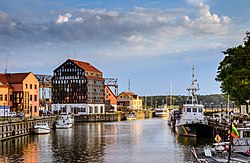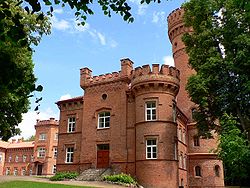- House of Perkūnas, Kaunas
- Spa town of Druskininkai
- Gate of Dawn, Vilnius
- Historic houses in Klaipėda
- A street in Kėdainiai
- Wooden church in Palūšė
- Lighthouse in Cape Ventė


Lithuania attracts many visitors from neighbouring countries and from all over the world. In 2018,there were 1.7 million foreign visitors to Lithuania for business, family and leisure. [1] The historical legacy of the Grand Duchy of Lithuania, its rich architecture, pristine nature, wellness services, seaside and spa resorts, gastronomy and cultural content are the main attraction points of Lithuania. [2] Domestic tourism is also highly popular: in 2018 it grew by 12%. Lithuanians also prefer to spend their vacations in Lithuania – 70 percent.[ clarification needed ] [3]
Contents
- Overview
- Statistics
- Arrivals by country
- Notable places
- Cities
- Towns and villages
- Specific destinations
- Protected areas and cultural heritage objects
- UNESCO World Heritage Sites
- Cultural routes
- Pilgrimage sites
- Resorts
- Resorts 2
- Resort territories
- Former places
- Military heritage
- Bicycle tourism
- Festivals
- Museums
- Gallery
- See also
- References
- External links


























